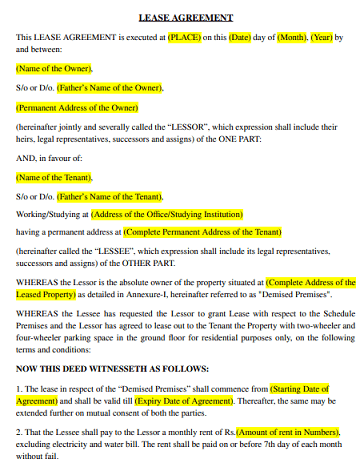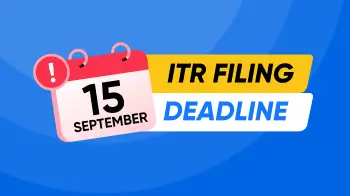Lease Agreement - Format, Contents & Terms - Download Template
When any person wants to take a property on lease, he/she must enter into an lease agreement with the owner of the property (lessee). It outlines the conditions of the lease arrangement so that the lessor (person taking property on lease) and lessee understands his rights and obligations under the lease.
This article covers more about lease agreement, its types, format, sample and contents.
What is a Lease Agreement?
A lease agreement is an arrangement between two parties – lessor and lessee, by which the lessor allows the lessee the right to use a property owned or managed by the lessor for a specified period of time, in exchange for periodic payment of rentals.
The agreement does not provide ownership rights to the lessee. However, the lessor may grant permission to the lessee to modify or change the property to suit his needs. The lessee is responsible for the condition of the property during the lease period.
Lease agreements may be used for the lease of properties, vehicles, household appliances, construction equipment, and other items.
Download Lease Agreement Format
Types of Lease Agreement
Below are the major types of lease agreements in India:
Residential Lease Agreements:
Residential lease agreements are agreements to lease houses or apartments for residential purposes. They are usually entered into for 12 or more months and contain the terms of the rent, how the property can be used by the lessee, and payments relating to repairs and maintenance.
Commercial Lease Agreements:
Residential lease agreements are entered for leasing properties for commercial purposes like offices, stores or industries. The terms of these agreements are usually longer and more complex than residential leases. It contains terms about business hours, business operations and things that can be carried out in the space.
Fixed-Term Lease:
Fixed-term lease agreements have a fixed lease period, like 1 year or 5 years. They are usually entered into between the parties for a long time and provide stability since the rent and rules remain the same for the fixed lease period.
Month-to-Month Lease:
These lease agreements are entered into for a month and are renewed every month. They offer flexibility to the parties in the lease since the rules or the rent amount can be changed while renewing for the next month. However, they provide less security as they can be terminated without proper notice.
Sublease Agreement:
Sublease agreements are when a lessee can further rent the leased property to someone else. Here, the lessee is responsible to the lessor. However, the provision for sublease must be mentioned in the original lease agreement between the lessee and lessor, and the lessor usually needs to approve the sublease by the lessee.
Contents of a Lease Agreement
Common contents of a lease agreement include:
- Names of the lessor and lessee or their agents.
- Description of the property.
- Amount of rent and due dates, grace period, late charges.
- Mode of rent payment.
- Methods to terminate the agreement prior to the expiration date and charges if any.
- Amount of security deposit and the account where it is held.
- Utilities furnished by the lessor and, if the lesser charges for such utilities, how the charge will be determined.
- Amenities and facilities on the premises which the lessee is entitled to use such as swimming pool, laundry or security systems.
- Rules and regulations such as pet rules, noise rules and penalty for violation.
- Identification of parking available, including designated parking spaces, if provided.
- How tenant repair requests are handled and procedures for emergency requests.
Lease Agreement Sample
Below is the sample of the draft lease agreement:

Terms Commonly Included in a Lease Agreement
Duration: Period for which the lease agreement will be in effect.
Rent: The consideration or payment made by the lessee to the lessor in exchange for the property leased out.
Deposits: The amount of deposit required (if any), the purpose of each deposit, and conditions for return or adjustment of deposit at the end of the lease period.
Terms of Use: The purpose for which the property is to be used and terms and conditions regarding use of the property.
Utilities: Which utilities are included in the rent, and which utilities the tenant is responsible for.
Insurance: Whether the lessee is required to ensure the property – this is most often used in commercial rental agreements.
Repairs and Maintenance: Party responsible for repairs and maintenance of the property – lessor or lessee.
A lease agreement is a legal document containing the terms and conditions for the lease of a property of the lessor to the lessee. It is a formal agreement where the lessor provides his property for the use of the lessee upon payment of rent. The lease agreement will contain the details the lease duration, maintenance responsibilities, and other crucial aspects of the lease arrangement.
Related Articles:

